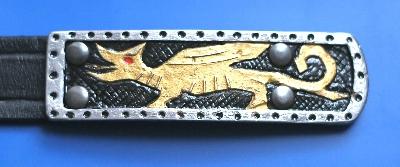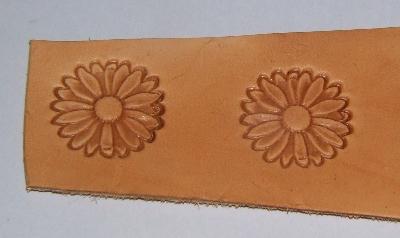-
Posts
5,928 -
Joined
Content Type
Profiles
Forums
Events
Blogs
Gallery
Everything posted by fredk
-
Try Copydex
-
I'm not exactly sure just what you did but usually when a thread breaks, go back about 3 stitches and just start sewing again. If you are doing two-needle saddler stitch then the broken thread will be locked into its holes by those three stitches. Just trim the broken thread off real neat. Glue on it helps but is not necessary with this method
-
There is or are formulas to work it all out but I do it another way. I cut the shape and size of the gusset piece, less the allowance for the skived and folded join, out of cardboard and use a fabric tape measure to measure round it. That gives me the front/base/back/across the top length for the inside of the leather that will be those sides. Then I just add how much I want the flap to come down over the front panel
-
again the difference. To most in the UK Capri means a car made by Ford, https://www.google.com/search?q=ford+capri&rlz=1C1CHBD_en-GBGB772GB772&source=lnms&tbm=isch&sa=X&ved=0ahUKEwjz_f7bxL3kAhUzoXEKHR-4D0gQ_AUIEigB&biw=1366&bih=625 or just maybe an island in the Mediterranean sea https://www.google.com/search?q=capri&rlz=1C1CHBD_en-GBGB772GB772&source=lnms&tbm=isch&sa=X&ved=0ahUKEwjz5Y30xL3kAhXuRxUIHZpHC7YQ_AUIEigB&biw=1366&bih=625 but I can't imagine anyone wearing either of those, with a belt or without!
-
Interesting. The OP doesn't say where he is located. Another difference between our countries. I've not yet come across any male trousers, of any sort, which will not take 1.75 inch [ 45mm ] wide belt. A lot of belts I made were in the 36 to 42mm widths [ 1.5 to 1.65 inches approx] with some to 1.75 and to 2 inch. 1.25 and under were rarely wanted except by medieval re-enactors
-

Belt Repair
fredk replied to TBigLug's topic in Purses, Wallets, Belts and Miscellaneous Pocket Items
Not just a noob question. I've been wondering why as well. Perhaps its cos if you do the 'hole' end you'll end up with a hole too close to the end. On US belts the buckle end can sometimes be easier as they like to have removable buckles but in the UK our buckles are usually not removable I've shortened belts by chopping off the 'hole' end and adding on a metal or leather tip to cover up the one or two holes closest to the tip. -
If you are thinking of making some belts for 'stock' and not-to-order I would make some in 1.25" and some in 1.75"
-
not really. I've done from 3/4 inch wide thru to 2.5 inch. Depends on what the customer wants
-
also, do not glue down nor sew the centre 1/2 inch
-
Try 1. dampen leather, not as wet as for moulding but as wet as for tooling 2. dilute the dye 3. dip dampened leather into diluted dye 4. leave leather in dye till dye soaks in, minutes not seconds 5. remove leather from dye, allow to partially dry 6. repeat 3, 4 and 5 as necessary until colour density is reached
-
With the mad rush over the Tandy Library website is running at a decent speed again. At least it was for me yesterday
-

Stepping back and restarting conservative - Singer 15-91
fredk replied to Vinito's topic in Leather Sewing Machines
On the matter of sand casting. I know it as 'oil sand'. I've used it for making belt ends amongst other things. The belt ends were made in pewter. I found this old picture of one I made a long time ago. The belt/strap end was copied from one found in a field. I made my original copy in layers of plastic card then packed oil sand under and on top of it. Split the oil sand mould, took out the plastic strap end, closed up the mould and poured in molten pewter through a pouring shaft hole. About 10 minutes later I split the mould and took out my metal strap end. The sand mould gets destroyed in taking out the metal strap end as some pewter is in the pouring hole and a vent shaft. But it only takes a few minutes to make the mould again -
I've used various methods. 1. multiple coats of thinned paint 2. sealing with a floor varnish. You don't say where you are. In the US you can get a floor 'polish' sometimes called 'Pledge with Future Shine'** or a similar name. It is not a floor polish but a water-thin acrylic varnish. A few coats of this makes a good sealer. Then paint silver, then white. ** Astonish in the UK 3. Tippex / white out. A thin coat of this before the white paint. If you can use the roll of Tippex tape as it is more of a physical barrier
-
Thats why I keep clear of white thread, could I ask, for you to put your locality in your 'profile? that way when we give any advice, especially on purchasing, we can be more specific for you and your area
-

Copying and copyright(ing) 'n' stuff
fredk replied to JLSleather's topic in Marketing and Advertising
and there I was think it was for recording personnel who were on 'a charge'. When I was in the RAF Officer Of The Day kept such a book, entering who was 'on a charge' and what for and determining who was 'carpeted' ie went before the Senior Officer, for punishment another example of different meanings in the two countries -
I've noticed that Tandy kits don't seem to give you the bast of anything but charge you top dollar for it. I have several types and sizes of threads. Currently two of my general purpose threads are 1mm and 0.65mm. Both are pre-waxed and flat in section. I buy my thread from Chinese sellers on ebay. Example below, most of these sellers can supply thread in different colours ~ I have threads in Brown, black, yellow, red, blue, purple et cetera. I like this thread as it is a. prewaxed, b. it lays down nicely when pulled tight example: https://www.ebay.co.uk/itm/260M-150D-1MM-Leather-Sewing-Waxed-Wax-Thread-Hand-needle-Cord-Craft-DIY-Ne-P9N1/143168155306 I have to import all of my leather work supplies. The thread order usually takes 10 to 20 days to arrive with me so I order well in advance of need, ie I keep a stock in hand I think for what you are doing and to suit your chisels 1mm thread is required. With pre-made holes, eg punched with chisels or made with a sewing awl you need Saddlers Harness needles. For 1mm thread I use John James size 2/0 or 1/0 Harness needles. For 0.65mm thread I use JJ size 4 . When sewing soft leather and I don't pre-punch holes Glover's needles are needed. For 1mm thread I use John James size 001 or Osborne 17 gauge, for 0.65mm thread I use JJ size 2 It was all trial and error for me too. I started with the small 'leather' needles in general purpose needle packs and a couple of very large spools [about 1500m each] of waxed Barbour thread I was given. [I still have some of those spools!] Others may chip in here and give their advice
-
a. do a search on here. there is somat about sending your photo to yourself via the phone and that resizes it to a size for pasting it here. I can't tell you more cos I use a photo-editing proggy to resize photos/ b. your thread looks a wee bit too small for the holes and are you waxing it enough?
-
sheesh, it was George 1st. Back on course; I advise people to take up with a good tannery/supplier and work up a relationship with them. I have with Le Prevo. I can tell them what I want the leather for and let them send me out something. In my 'medieval' period I was sometimes actually looking veg tan with surface scars, would you believe it? and thats what Le Prevo supplied
-

RFID wallet
fredk replied to Tim Schroeder's topic in Purses, Wallets, Belts and Miscellaneous Pocket Items
A. I put it just on the outside layer with a thin cloth liner glued over it, which also gets sewn at the edges b. don't bother with the fancy expensive RFID stuff. Aluminium tape used for insulating heating pipes is cheaper. £4.99 for a 50m roll. Its also thicker by a smidgen and self adhesive. It works fine & dandy -
to put my idea in action. I used a detailed 3D stamp. On 2.2mm veg tan [about 5-6 oz?] On the left, stamped on my block of marble, on the right, stamped on 3mm steel plate No real difference, only slightly due to me and how hard I whacked the handle. I use the real big handle and 'walked' the stamp in different directions to get the edges nicely done. Now, by comparison : my marble block is about 4" x 8" x 1.25" thick, it weighs 1.6Kg. The 3" square steel plate is 3mm thick and weighs 128g, so x4 for a 6" square is 512g. A 1/3 of the marble block, The 3mm plate can be stored and carried easier. For the scouts a piece of plate 3"x 6" would be plenty, that makes it 256g. or x 20 = 5.12Kg Plus, you can go to just about any builders suppliers and get the steel plate, cut to size too, for far less cost and easier to get than granite/marble blocks in quantity. Only down-side: the edges and corners of the steel plate will need smoothing, on either a double-wheel sander or with a sanding disc on an angle grinder or something Price wise, I paid 75p [about 90c] for the 3" square, about £1.50 [about $1.80] for a piece 8" square and I think the prices will be by far cheaper in the US
-

How to get your products to sell well
fredk replied to RockyAussie's topic in Marketing and Advertising
also consider how long the company is likely to exist in the future. In this 21st century even old companies are closing down at a fast rate. Many guarantees / warranties are worthless. Even when one company is taken over by another and looses its individual identity its warranties are ignored thereafter. I can give plenty of personally known examples but I'll not. Our guarantees / warranties must stand true I know a local artisan pottery which gives no guarantee on its works. Someone I know bought a nice looking coffee mug. Sold as such. Got it home, went to use. The mug was porous, like a sponge. Coffee all over the kitchen work top. She took the mug back to the pottery. Their reaction was 'So?' no money back no replacement mug - nowt. £15 wasted on a pen holder Our guarantees / warranties must stand true -
Its the hard surface you need. Try steel plate. 3mm thick by 6" square. I have a round block of steel I used to use as a portable anvil. Its about 4" diameter by 3" deep. Not only was it good for setting ready-rivets but I could do stamp impressions on it too. Many will tell you, not to put wet leather in touch with iron/steel but for the few minutes that the scouts need there'll be no problems, or to make your mind easy, paint the surface of the steel plate
-

How to get your products to sell well
fredk replied to RockyAussie's topic in Marketing and Advertising
btw, a 'life-time' guarantee is illegal** in EU law. afair it has to be in nominated years and be of reasonable length. The 100 years mentioned above would be out of order I think but 50 or 75 years would be fine ** but I don't care, so there -

How to get your products to sell well
fredk replied to RockyAussie's topic in Marketing and Advertising
I give a life-time warranty on all my goods plus free repair. In 20 years I've had two items back for repair. Both were really well used, the damage was due to wear-and-tear, but repair them I did. When asked what 'life-time' means, ie mine, the item's or the owner's? I tell 'em, mine or the item's which ever ends first For 16 years my brand was just - Fred. Cos I was fairly well known in the Historical Presentation/Re-enactment circles. Just "get Fred to make it/mend it" But since I left that scene I have to start over again. -
That sounds like a plan indeedy I've thought of another way; find a friendly hobbyist wood turner. Bribe with copious bottles of brew/wine/chocolates and ask him/her to turn it up copying a donor gaiter




